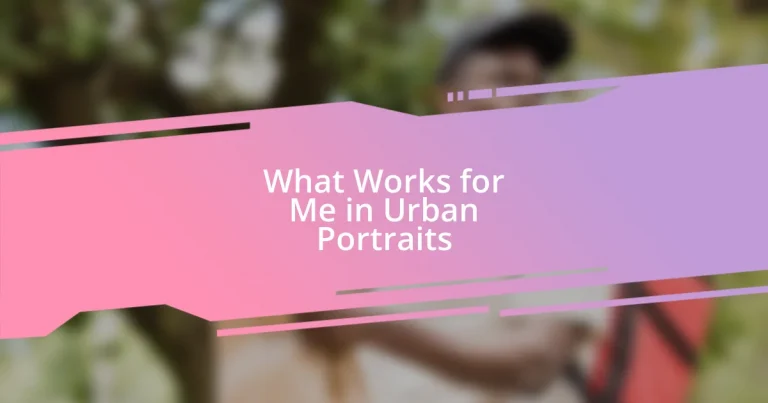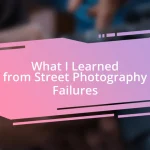Key takeaways:
- Urban portraits capture the essence of city life by highlighting the stories and emotions of individuals within their environments.
- Selecting the right location and utilizing natural light effectively can enhance the emotional impact of portraits, transforming ordinary scenes into compelling narratives.
- Engaging with subjects and thoughtfully incorporating urban elements in compositions can create authentic connections and elevate the storytelling quality of photography.

Understanding Urban Portraits
Urban portraits are more than just photographs; they capture the spirit of the city and its inhabitants. I remember a day when I stumbled upon a mural in a bustling neighborhood, depicting local history alongside the faces of everyday people. How could I not feel a surge of inspiration? The raw emotions and stories etched in their expressions seemed to resonate with the very essence of urban life.
What strikes me most about urban portraits is the depth of connection they create between the viewer and the subject. Each face has a story, a background, and within that moment captured, you can almost hear the city’s heartbeat. I often find myself pondering: What untold narratives are hidden behind those smiles or frowns? This curiosity pushes me to explore further, diving into diverse communities and learning from their unique perspectives.
In my experience, the environment plays a crucial role in shaping urban portraits. The street corners, cafes, and markets offer a rich tapestry of textures and colors that frame the subjects. I once took a portrait in a vibrant alleyway filled with graffiti, and it immediately transformed a simple image into a powerful statement about identity and culture. How does the setting influence how we perceive the person in the frame? That’s the beauty of urban portraiture—it invites endless exploration and interpretation.

Choosing the Right Location
Choosing the right location for urban portraits is essential. I always consider how different settings can evoke varying emotions. For instance, capturing someone in front of a lively street food market radiates joy and energy, while a quiet park might convey introspection and serenity. I recall a time when I decided to photograph a musician on a crowded subway platform. The rush of commuters around him highlighted his solitude, creating a powerful contrast that told a unique story.
When scouting locations, I look for places that reflect the personality of my subject. A skateboarder in an urban skate park feels at home among ramps and graffiti, while an elderly woman might shine in a picturesque botanical garden. It’s fascinating to see how the environment amplifies the narrative within the portrait, aligning the subject’s lifestyle with the visual context. I once photographed a fashion designer amidst fabric stalls in a bustling market, and the vibrant backdrop beautifully echoed her creative spirit.
Moreover, the lighting and time of day can dramatically transform a scene. I cherish the golden hour just before sunset; soft, warm light can turn an ordinary street into a canvas of hues. One evening, I snapped portraits of friends against an exquisite backdrop of old brick buildings glowing in twilight. The results were nothing short of magical. Choosing the right location isn’t just about aesthetics; it’s about crafting a story that resonates deeply with the viewer.
| Location Type | Emotional Influence |
|---|---|
| Street Food Market | Joy and Energy |
| Quiet Park | Introspection |
| Skate Park | Freedom and Youth |
| Botanical Garden | Peace and Reflection |

Utilizing Natural Light Effectively
Natural light can be a photographer’s best friend, especially in urban settings where harsh artificial lighting can diminish a subject’s essence. I always strive to utilize natural light to its fullest potential. One sunny afternoon, while walking through the city, I discovered an alley drenched in golden sunlight. I quickly invited a friend to step into the light, and the way it danced across her face added depth and warmth to the portrait. That moment reminded me how the quality of light can create an emotional connection, transforming a simple photograph into a vibrant story.
To harness natural light effectively, consider these key points:
- Time of Day: Early morning and late afternoon are ideal for soft, flattering light. Avoid midday sun, which can cast harsh shadows.
- Shadows and Highlights: Use shadows creatively to add dimension. I’ve found that the interplay between light and shadow can enhance a subject’s features beautifully.
- Reflectors: I often carry a simple white board or reflector. It can bounce light back onto the subject, brightening their face and reducing shadows.
- Overcast Days: Soft, diffused light on cloudy days can create wonderfully even skin tones, perfect for intimate portraits.
- Background Light: Pay attention to how light falls on the background. A well-lit environment can enhance the overall impact without overpowering the subject.
Utilizing natural light not only illuminates the subject, but it also reflects their personality and the mood of the day. I reminisce about a project where I photographed a dancer during sunset. The fading light enveloped her in a warm glow, making her movements seem almost ethereal. Each click of the shutter felt like capturing a fleeting moment, a dance between her energy and the day’s waning light.

Engaging with Your Subjects
Engaging with your subjects can transform a portrait into a powerful narrative. I remember a time when I approached a street performer playing guitar in the park. Instead of just taking photos, I asked him about his music, his inspirations, and his stories. This conversation not only put him at ease but also brought out a genuine smile that illuminated his face, making the portrait far more captivating than a simple snapshot.
I think many photographers overlook the importance of connection. When I photograph a person, my goal is to create an atmosphere that fosters openness. I often share a quick anecdote or compliment to break the ice. Once, while photographing a couple, I noticed a small detail: the way they shared a shy glance. I paused, complimented their connection, and it sparked laughter. That moment of shared joy turned into one of my favorite shots, capturing their authentic relationship in a single frame.
Additionally, body language plays a crucial role in conveying emotion. I consciously look for ways to encourage my subjects to express themselves. When capturing a friend who was nervous in front of the camera, I had them strike poses they’d normally do in their downtime, like leaning against a wall casually or pretending to chat with me. Their relaxed stance not only transformed their demeanor but also added a layer of authenticity to the final portraits, revealing a side that might otherwise have remained hidden. How often do we find that the best expressions come from moments of candid vulnerability?

Incorporating Urban Elements
Incorporating urban elements into portraits can breathe life into your images. I often find myself drawn to the textures and contrasts of cityscapes. One of my favorite experiences was photographing a friend near a vividly graffitied wall. The vibrant colors and intricate designs not only enhanced her style but also told a compelling story, wrapping her individuality in the spirit of the urban environment. It made me realize that backgrounds can almost become characters themselves.
I’ve also learned to embrace the clutter and chaos that cities present. Urban settings are filled with unique shapes, colors, and patterns that can complement or juxtapose your subject. I remember a shoot where I positioned a model against a busy street scene while she waited for a signal to cross. The motion of the cars and pedestrians provided an electric energy to the portrait, creating a sense of urgency and life that resonates with anyone familiar with urban chaos. Isn’t it fascinating how a simple moment can capture the pulse of a city?
Another technique I employ is using architectural lines to draw attention to my subjects. Once, I was in a concrete park, and the stark lines of the buildings surrounding us created a powerful framing device. By aligning my subject slightly off-center, I added dimension to the image, directing the viewer’s eye through the frame. It made me ponder—how often do we overlook the beauty in the structures around us that can elevate a portrait from ordinary to extraordinary? Each unique feature can serve as a thoughtful reminder of the urban landscape’s impact on human expression.

Tips for Post-Processing
Post-processing can be where the magic truly happens in urban portraits. I remember spending hours carefully adjusting the contrast in a photo I took on a bustling street. I wanted to highlight the interplay of shadow and light that danced through the scene. That subtle tweak transformed an ordinary shot into one that exuded an urban vibe, making the viewer feel the pulse of the city. How much difference can a little adjustment make?
One thing I’ve found is that color grading plays a significant role in conveying mood. For example, I had a shoot at sunset where the colors were already incredible, but I decided to enhance the warm tones while slightly desaturating the background. This helped to create an intimate feel that drew the viewer’s eye directly to my subject’s expression. It’s fascinating how a simple shift in color can evoke emotions and narratives—what stories are your photos telling?
When it comes to cropping, I approach it like sculpting a block of marble. Once, I captured an expressive portrait, but the background was a bit cluttered. By carefully cropping in, I eliminated distractions and ensured the focus remained on my subject’s captivating gaze. Good composition doesn’t just happen in-camera; post-processing is crucial for refining the story you want to tell. How often do we forget that simple tools can elevate our work into something truly striking?

Building Your Photography Portfolio
Building a photography portfolio is like curating a personal gallery that showcases your unique perspective. When I approach this task, I focus heavily on diversity—both in subjects and settings. For instance, I remember a series where I combined portraits of people in tranquil parks with energetic street scenes. This contrast told a compelling story about how urban life is a blend of chaos and calm, drawing viewers into a narrative that reflects their own experiences in the city. What stories do you want your portfolio to tell?
As I built my portfolio, I realized the importance of consistency in style and mood. I often experiment with different editing techniques, but keeping a cohesive theme helps unify the collection. I once invited a photographer friend to collaborate on a project where we both shot the same location but from contrasting angles. The result was enlightening; his vibrant, high-contrast images beside my softer, moody portraits created a beautiful juxtaposition. I found that this variety not only enriches my portfolio but invites conversations about artistic choices. Have you considered how varying styles can act as a dialogue within your work?
Another crucial aspect of portfolio building is reflection. After each shoot, I spend time reviewing my images, selecting not just what looks good, but what resonates emotionally. I recall a moment when I captured a street musician lost in his music, his face a canvas of emotions. That photo became a defining piece in my portfolio because it encapsulated a fleeting moment of genuine expression. It made me ponder: are we showcasing clear emotions in our work, or are we just filling our portfolios with pretty pictures? Each image should connect with viewers and convey authenticity—does yours?














